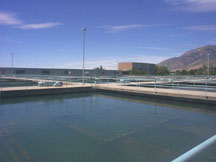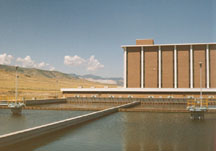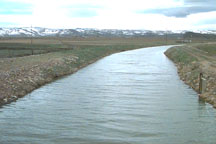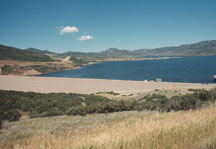Bulletin Board
|
|
Salt Lake County Water Supply and Capital Needs
May 1, 2000
Sandy City – On April 25, 2000 Wasatch Front water officials summed up their water supply and capital needs to meet the future needs of Salt Lake County. Presentations from the Metropolitan Water District of Salt Lake City (MWD), Jordan Valley Water Conservancy District (JVWCD), Provo River Water Users Association (PRWUA) and the Central Utah Water Conservancy District (CUWCD) outlined water development projects for the beginning of the twenty-first century. The four water agencies described capital improvements necessary to ensure adequate water supply for the Wasatch Front totaling over $2.1 billion. Most of the 200 in attendance were associated with one of the presenting water agencies. The purpose of the meeting was to bring each agency up to date on the other agencies’ master plans. Mayor Dolan welcomed those in attendance.
Metropolitan Water District of Salt Lake City
Nick P. Sefakis, MWD general manager, led off the discussion by presenting the MWD Master Plan for the 21st Century. He told the audience that MWD was formed in 1935 after a drought to build Deer Creek Reservoir on the Provo River. MWD’s two member cities are Salt Lake City and Sandy City. Water is also sold to the JVWCD and irrigators. Five board members from Salt Lake City and 2 members from Sandy City are appointed by the respective city councils. The district’s water sources are Little Dell, Jordanelle and Deer Creek Reservoirs as well as Little Cottonwood Creek, amounting to 120,640 acre-feet of supply. Mr. Sefakis noted that Salt Lake City and Sandy City completed master plans in 1997. MWD took that data and conducted its master plan with a consortium of engineering firms. Completed in 1998, the analysis studied 22 alternatives before the MWD Board of Directors approved the final option. Conservation was a key element of the study. The new facilities were needed to meet the population growth of Salt Lake City and Sandy City to the year 2025. Salt Lake City’s service area is expected to grow from 332,000 to 433,000 people over the planning period, and Sandy City’s from 101,000 to 131,000 -- an increase of 30.2 percent. The capacity necessary to treat and convey the water supply will increases from the present 163 MGD to 248 MGD, leaving the need to construct 85 MGD of new capacity.
|
|
Water Conservation is part of MWD's master plan. The district supports its member cities’ efforts to conserve water. Mr. Sefakis applauded Salt Lake City adopting conservation rates.
Mr. Sefakis said that the cost of the new treatment and conveyance facilities would be $188 million. In conclusion, a view of the Provo River Power Plant, located at the base of Deer Creek Reservoir was shown in its early stages of construction in the early 1940s. The caption read, “Planning for the Future – Grateful to the Past.” Mr. Sefakis noted “We need to do for our children and grand children what our forefathers did for us, and provide a water supply for their future.”
Jordan Valley Water Conservancy District
Richard Bay, chief engineer, Jordan Valley Water Conservancy District, described the district’s service area. Established in 1951, the district serves water to a population of 800,000 with wholesale and retail water deliveries to most communities within Salt Lake County. It serves wholesale water to 20 member agencies. Since its inception in 1951 water deliveries have grown to 80,000 acre-feet in 1999.
Mr. Bay said that most of the fastest growing communities in Utah are within the boundaries of the district and the population served will double within the next 20 years. Studies indicate that the district’s water deliveries will grow to over 250,000 acre-feet of water by 2035. Water conservation plays a key role in the district’s water plan. It has instituted a comprehensive program that includes residential water surveys (water checks), model landscape ordinances, public education, demonstration gardens and landscape/irrigation loan programs.
JVWCD’s current water supply comes from wells, Jacob - Welby exchange and 50,000 acre-feet of water from the Central Utah Project. Water is also purchased from the MWD.
New water supplies will come from drilling high quality wells and surplus water from the MWD. Currently JVWCD is drilling 15 new wells that will produce between 10,000 to 13,000 acre-feet of water. Future water supply developments include, Southwest Valley Groundwater Remediation Project, Utah Lake development and shallow ground water development along the Jordan River. Membrane treatment (reverse osmosis) technology will be used in treating these water supplies. The Bear River Project will be needed in about 2015. The project was authorized by the state legislature under the 1991 Bear River Development Act. The project will develop 210,000 acre-feet of water supply. The JVWCD and Weber Basin Water Conservancy District each have been allocated 50,000 acre-feet of water from the project. A Bear River division is proposed near Honeyville. A 210 MGD water treatment plant and 43-mile aqueduct will convey water southward to Salt Lake County. The last blocks of water proposed are treatment of shallow groundwater wells and recycled wastewater.
|
|
Provo River Water Users Association
G. Keith Denos, Superintendent, described the purpose of the PRWUA. The organization was formed in 1935 to sponsor the Provo River Project. It is a private not for profit corporation. The MWD is the largest stockholder with 61,700 of the 100,000 shares. The Provo River Project was authorized in 1933 and construction began in 1938. The project was to develop supplemental agricultural and M&I water supply. Deer Creek Reservoir (150,000 acre-feet of capacity) is the major feature of the project with diversions from the Weber and Duchesne Rivers. The Murdock diversion on the Provo River and the Provo Reservoir Canal conveys project water to stockholders in northern Utah and southern Salt Lake Counties. Deer Creek Reservoir yields 100,000 acre-feet of water from annual diversions of 35,000 acre-feet from the Weber River, 25,000 acre-feet from the Duchesne River and 40,000 acre-feet from the Provo River.
|
|
Central Utah Water Conservancy District
Tim Doxey, Salt Lake County Board Member and Chair of the Engineering Committee, described the Bonneville Unit and District features. The CUWCD operates and maintains 8 dams with 1.6 million acre-feet of storage capacity, three main river diversions, 70 miles of large diameter tunnels and pipelines and three water treatment plants.
|
|
Robert Weyher, vice chairman of the CUWCD Board, told the audience that CUWCD's budget for the years 2000 – 2010 showed a deficit of $63,986,000. The deficit will reduce their reserves. Also they show a reduction in taxes beginning in 2011. “Neither the Provo Reservoir Canal or the Point of the Mountain Water Treatment Plant are in the budget,” exclaimed Weyher. He said that the Board has not considered participating in these two projects The Ohmsted Flowline and the Utah Valley Water Treatment Plant are included in the budget. The final decision on the SFN is in the future.
Mr. Weyher encouraged more water conservation. He praised Salt Lake City's conservation rates and said that CUWCD’s conservation goal is now 25 percent. So far the district has conserved 18,000 acre-feet of water under the Central Utah Project Completion Act (Section 207 Water Management Improvement of the Act). The goal is 40,000 acre-feet.
The meeting was adjoured at 8:00 p.m. without questions and answers.




